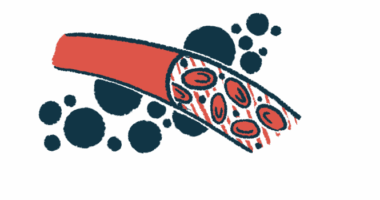Amondys 45 (casimersen) for Duchenne muscular dystrophy
What is Amondys 45 for muscular dystrophy?
Amondys 45 (casimersen) is an approved exon-skipping therapy for Duchenne muscular dystrophy (DMD) patients with mutations amenable to exon 45 skipping.
The treatment is infused into the vein, or intravenously, and is Sarepta Therapeutics’ third exon-skipping therapy to be approved by the U.S. Food and Drug Administration (FDA) for DMD patients. It joins Exondys 51 (eteplirsen) for patients amenable to exon 51 skipping and Vyondys 53 (golodirsen) for those with mutations amenable to exon 53 skipping.
Therapy snapshot
| Brand name: | Amondys 45 |
| Chemical name: | Casimersen |
| Usage: | Treatment for DMD patients with mutations amenable to exon 45 skipping |
| Administration: | Intravenous infusion |
How does Amondys 45 work?
DMD is a rare genetic disease wherein mutations in the DMD gene lead to a complete or near complete lack of functional dystrophin, a protein essential for muscle health. Over time, people with DMD have symptoms of progressive muscle weakness and degeneration.
The largest in the human genome, the DMD gene consists of 79 exons, which are portions of a gene that code for protein. DMD-causing mutations can occur at various places on this gene and usually result in one or more exons being lost. The remaining ones don’t fit together properly and functional dystrophin can’t be produced.
Amondys 45 is an exon-skipping therapy, which works to skip over certain exons, letting the remaining ones fit together better. This enables a shorter, but still functional dystrophin protein, to be produced.
Using Sarepta’s proprietary technology, Amondys 45 directs muscle cells to skip exon 45 in the DMD gene. By allowing some dystrophin to be produced, the treatment is intended to slow muscle strength declines for the roughly 8% of patients with mutations that can be treated by skipping exon 45.
Who can use Amondys 45?
The FDA granted accelerated, or conditional, approval to Amondys 45 in February 2021 for DMD patients with mutations amenable to exon 45 skipping. Conditional approval means that, while the therapy can be marketed, additional clinical trial data are still needed for full approval.
Who should not use Amondys 45?
Patients who have allergic reactions to casimersen or any other ingredients in Amondys 45 should not use the therapy.
How is Amondys 45 administered?
Amondys 45 is administered intravenously at a dose of 30 mg per kg of body weight once a week by a healthcare provider. Each infusion takes about 35 minutes to an hour.
The medication comes in single-dose vials of 100 mg casimersen dissolved in 2 mL of sterile solution. This will be diluted to the appropriate dosage for each patient by their healthcare provider.

Amondys 45 in clinical trials
A randomized, placebo-controlled Phase 1 study (NCT02530905) evaluated the safety, tolerability, and pharmacological properties of Amondys 45 in 12 patients, ages 7-21, with advanced-stage DMD who had mutations amenable to exon 45 skipping.
Participants were randomly assigned to receive increasing doses of Amondys 45 or a placebo for 12 weeks before entering an extension period where they all received Amondys 45 for up to 144 weeks, or more than 2.5 years. The study found Amondys 45 was safe and well tolerated, and showed little to no accumulation in the blood with the weekly dose of 30 mg/kg of body weight.
Ongoing trials
The conditional approval of Amondys 45 was based on preliminary data from the Phase 3 ESSENCE clinical trial (NCT02500381).
ESSENCE trial
The global ESSENCE study enrolled 229 boys with DMD, ages 6-13, who are amenable to exon 45 (Amondys 45) or exon 53 (Vyondys 53) skipping.
The participants were randomly assigned to receive active treatment or a placebo as a once-weekly infusion into the bloodstream for up to 96 weeks, or nearly two years. This will be followed by an open-label extension wherein all will be given active treatment for another 48 weeks, or about a year.
The trial’s main goal is to assess changes in muscle strength and functional abilities, as measured by the six-minute walk test. Secondary goals include changes in dystrophin production and respiratory function.
Interim 48-week analyses of 27 participants given Amondys 45 and 16 given a placebo were used to support the FDA’s conditional approval. Data showed that those given Amondys 45 had a statistically significant 0.81% increase in dystrophin levels in muscle biopsies after about a year. Analyses indicated exon 45 was effectively skipped, with a positive correlation between exon 45 skipping and dystrophin production.
ESSENCE is expected to conclude in 2025. It is serving as a post-marketing confirmatory trial for both Amondys 45 Vyondys 53.
Other trials
An open-label Phase 2 Phase 2 trial (NCT04179409) was designed to evaluate the safety and efficacy of Amondys 45, Vyondis 53, and Exondys 51 in patients who have a duplication of exon 45, 53, or 51, respectively. This means they have two copies of the exon when there would normally only be one. It has enrolled three males who are receiving treatment for about a year, with a main goal of evaluating changes in dystrophin levels.
Common side effects of Amondys 45
The most common side effects associated with Amondys 45 include:
- upper respiratory tract infections
- cough
- fever
- headache
- joint pain
- oropharyngeal pain, or pain affecting the part of the throat behind the mouth.
Allergic reactions
Allergic reactions have occurred in patients treated with Amondys 45, including angioedema (swelling) or anaphylaxis, both of which are severe and potentially life-threatening conditions. If such a reaction occurs. Amondys 45 infusions may need to be slowed, interrupted, or discontinued until the condition resolves.
Kidney toxicity
Kidney toxicity was observed in preclinical studies of Amondys 45. Although kidney toxicity was not observed in clinical trials, other medications in its class have been associated with potentially fatal kidney toxicity.
Kidney function should be monitored in patients taking Amondys 45 via urine and blood testing, including before starting treatment and routinely while using the therapy.
Muscular Dystrophy News is strictly a news and information website about the disease. It does not provide medical advice, diagnosis or treatment. This content is not intended to be a substitute for professional medical advice, diagnosis, or treatment. Always seek the advice of your physician or other qualified health provider with any questions you may have regarding a medical condition. Never disregard professional medical advice or delay in seeking it because of something you have read on this website.
Related article

 Fact-checked by
Fact-checked by 




